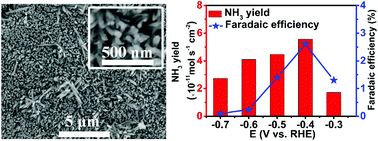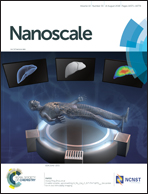Ambient N2 fixation to NH3 electrocatalyzed by a spinel Fe3O4 nanorod†
Abstract
Industrially, NH3 is mainly produced via the Haber–Bosch process which is not only energy-consuming but emits a large amount of CO2. Electrochemical reduction is regarded as an environmentally-benign alternative for sustainable NH3 synthesis, and its efficiency heavily depends on the identification of Earth-abundant catalysts with high activity for the N2 reduction reaction (NRR). In this work, we report that a spinel Fe3O4 nanorod on a Ti mesh (Fe3O4/Ti) acts as an efficient and durable NRR electrocatalyst under ambient conditions. When tested in 0.1 M Na2SO4, such Fe3O4/Ti achieves a high faradaic efficiency of 2.6% and a NH3 yield 5.6 × 10−11 mol s−1 cm−2 and at −0.4 V vs. a reversible hydrogen electrode.



 Please wait while we load your content...
Please wait while we load your content...